Time Travel Research Center © 2005 Cetin BAL - GSM:+90 05366063183 - Turkey/Denizli

NUCLEAR CHEMISTRY
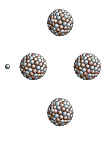
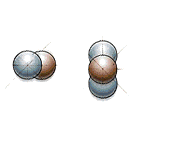
FISSION v.s. FUSION
NUCLEAR FISSION
A fission reaction involves the splitting of atomic nuclei into two or more parts after colliding with a free neutron. Uranium is the only natural element that can easily be split. The small particless of the nuclei that split, travel at an incredible speed and collide with other uranium nuclei causing them to split. This process causes a chain reaction creating heat from the kinetic energy of the quickly moving particles. The heat is used to convert water to steam which turns a turbine which turns a generator and creates electricity.
Below is a diagram showing nuclear fission:
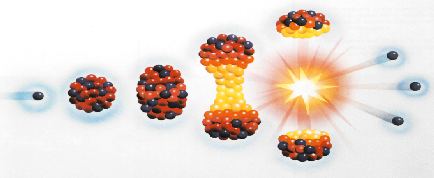
To provide protection for the outside environment, there are a number of sheids surrounding this reaction. The first barrier is the nuclear fuel which is formed in solid ceramic pellets. Most of the radioactive-by-products are contained in the pellets. The pellets are then contained in special steel rods that ate 12 feet long and half an inch in diameter. The fuel rods are then enclosed in a large steel pressure vessel with 9 inch thick walls, which is encased in a steel plate shell. Then the vessel is contained in a massive reinforced steel containment structure with walls exceeding 3 feet in width.
Nuclear Fusion is a process in which hydrogen atoms fuse to form helium atoms. The advantages to this are that this process produces the same amount of energy, kilogram for kilogram, as the best modern energy source, nuclear fission. Nuclear fission also does not produce dangerous radioactive waste--only helium.
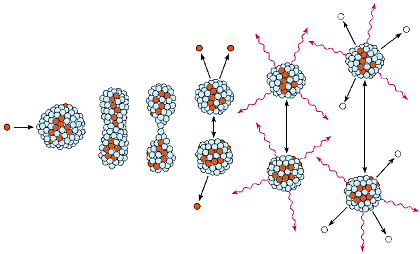
The process of nuclear fusion, evident in stars, including the Sun, releases enormous amount of energy. It occurs when the nuclei of lighter elements (such as Hydrogen) are fused together at extremely high temperatures and pressures to form heavier elements (such as helium). The core of the sun is estimated to be 27 million degrees fahrenheit. At this extreme temperature, hydrogen atoms melt, or fuse together releasing tremendous amounts of heat and light.
The disadvantage of nuclear fusion is that it is very hard to get a self-sustaining fusion reaction going. The reason for this is that you have to heat the hydrogen up to extreme temperatures. Quite often, it takes more energy to do so than is produced in the reaction.

People are working on ways to make it practical, but it is unlikely that nuclear fusion will become a viable energy source before about 2015 or so.
Even in fusion bombs, a small fission warhead must be detonated first, to generate enough heat to sustain the fusion reaction.

An example of nuclear fission is the chain reaction: n+u = Kr+Ba+3n, where the capture of a neutron (n) by an uranium nucleus (U) leads to a break-up (Fission) of the uranium into the two nuclei of krypton (Kr) and barium (Ba) and the release of three neutrons (3n).
What is Fusion?
What is nuclear fusion?
What is nuclear fusion? Simply, fusion is when two elementary particles collide and combine or fuse to make -- even temporarily -- a new particle. In the graphic below, a form of the hydrogen nucleus -- Tritium -- collides with another form of the hydrogen nucleus -- Deuterium -- to form a new particle. (Deuterium and Tritium are isotopes of hydrogen -- a form of water.) The fused particle is not stable, and quickly decays via the split decay mode into a neutron -- moving very fast, i.e., "hot" -- and a helium neucleus -- also know as an "alpha" particle and energy.
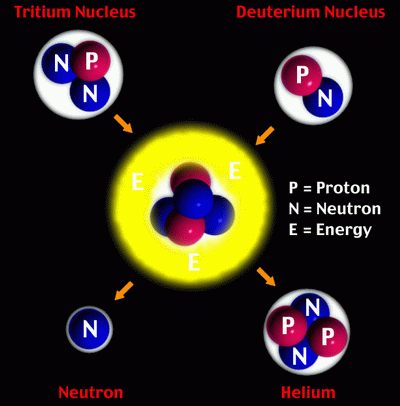
What is nuclear fission?
What is nuclear fusion? Fission is the opposite of fusion. A heavy elementary particle, splits into two or more lighter particles. (Note: during the fusion process, fission does occur in the second half of the process. When the large, unstable particle in the graphic above splits into the the neutron and the helium nucleus, it is a form of fission.) Normally, people associate the fission process with heavy elements like uranium or plutonium splitting into lighter elements.
Radioactive Waste
The radioactive by-products from fission are undeniably bad. They last for tens of thousands of years and can cause untold problems, the worst of which is through terrosists using the waste products for weapons. The fast neutron from fusion can potentially interact with metals a cause them to become radioactive. This process can be minimized by have neutron shielding between the fusion burn and any metals in the reactor. However, the radioactive metals produced -- and any ash from the fusion burn itself -- is a low-level radioactivity that is not considered dangerous, with half-lives in the tens of years. There is no comparison -- radioactive waste from fission is very dangerous, radioactive waste from fusion is not very dangerous.
The energy from fusion or fission
When fission or fusion occurs, the process of converting elementary particles from one type of particle to another is not "perfect." If you were to measure the mass of the particles after fusion or fission, the total mass would be less than before. For example, typical fusion reactions and the energy released are given in the table below:
| D + D | He3 + n |
3.27 MeV
|
| D + D | T + p |
4.04 MeV
|
| T + D | He4 + n |
17.26 MeV
|
| He3 + D | He4 + p |
18.34 MeV
|
| Li6 + D | 2He4 |
22.4 MeV
|
| Li7 + p | 2He4 |
17.3 MeV
|
| He3 + He3 | 2p + He4 |
12.86 MeV
|
It is hard for most people to understand where this energy comes from, and how much it is. Most people have heard of Einstein's famous equation:
E = mc2
When the fusion reactions listed above occur, a small amount of mass disappears. The small amount of mass is converted into a large amount of energy. How much is large? A typical chemical reaction in which hydrogen and oxygen combine to produce water, releases about 1 eV of energy. The fusion process typically releases 1,000,000 times as much energy. Historically, when people talk about the benefits of nuclear fusion, they refer to how much fuel must be burned to equal to each other.
| Process | Fuel | Amount |
| Fusion | Deuterium & Tritium | 1/2 ton pickup truck |
| Fission | Uranium Oxide | 1.5 train-car loads |
| Solar | Sun | 5000 acres of solar collectors plus energy storage for night and cloudy days |
| Burning Oil | Oil | 11 super tankers |
| Burning Coal | Coal | 250 train loads |
This does not even talk about pollution comparisons. I will put up another page on the overall benefits of nuclear fusion, but suffice to say, the relative amount of pollution for nuclear fusion is dramatically less than the other processes.
Conclusion
Nuclear fusion takes water, burns it, releases helium (and a small amount of radiation in the form of neutrons), and converts the missing mass into massive amounts of energy.
Hiçbir yazı/ resim izinsiz olarak kullanılamaz!! Telif hakları uyarınca bu bir suçtur..! Tüm hakları Çetin BAL' a aittir. Kaynak gösterilmek şartıyla siteden alıntı yapılabilir.
The Time Machine Project © 2005 Cetin BAL - GSM:+90 05366063183 -Turkiye/Denizli
Ana Sayfa /İndex /Roket bilimi / ![]() E-Mail /CetinBAL /Quantum Teleportation-2
E-Mail /CetinBAL /Quantum Teleportation-2
Time Travel Technology /Ziyaretçi Defteri / Duyuru / UFO Technology